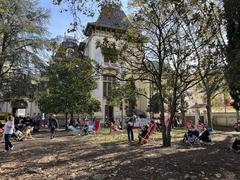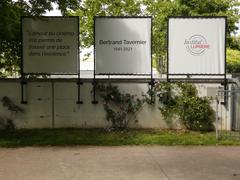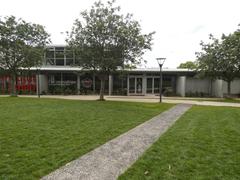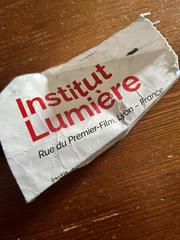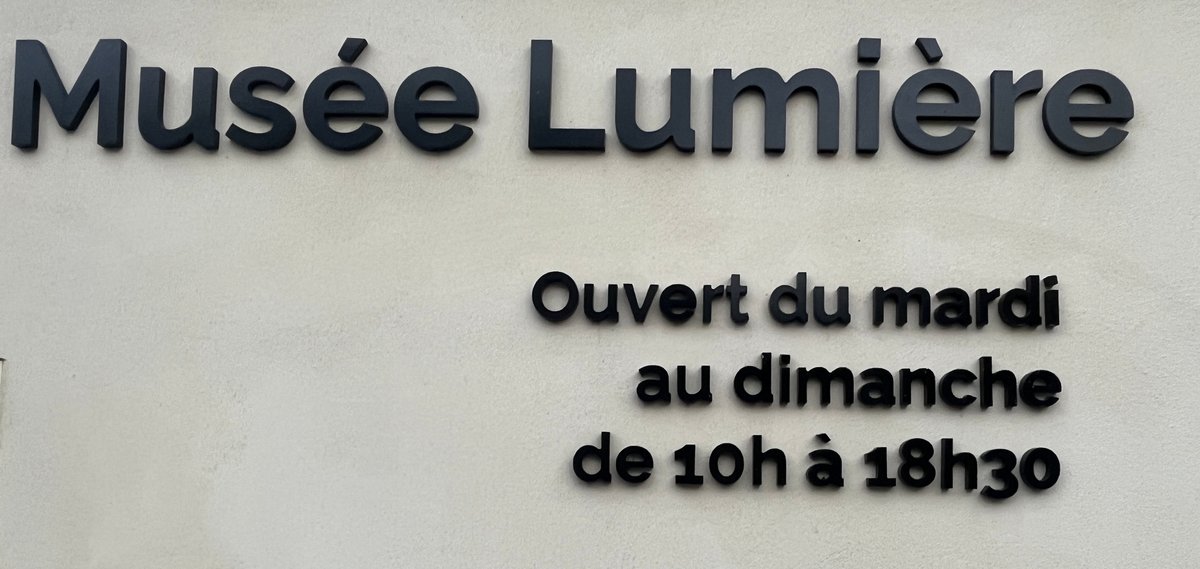
Institut Lumière Lyon: Visiting Hours, Tickets, and Historical Significance
Date: 14/06/2025
Introduction
Nestled in Lyon’s vibrant Monplaisir district, the Institut Lumière stands as a living monument to the birth of cinema and the pioneering Lumière family. This iconic site encompasses the elegant Villa Lumière—the family’s former residence—and the original factory hangar, where Auguste and Louis Lumière invented the Cinématographe in 1895. Their invention transformed moving images from a curiosity into a collective art form, and their very first film, La Sortie de l’Usine Lumière à Lyon, is recognized worldwide as a foundational moment in cinema history.
Today, the Institut Lumière preserves this remarkable legacy through museum collections, film screenings, exhibitions, and educational programs. It is not only a site of historical significance but also a dynamic cultural hub, hosting international festivals, retrospectives, and special events that celebrate both classic and contemporary film arts. Whether you are a cinema enthusiast, history buff, or traveler seeking Lyon’s rich heritage, the Institut Lumière offers an unparalleled window into the origins and evolution of cinema (Institut Lumière; Phong Nha Explorer; This is Lyon).
Table of Contents
- The Lumière Family and the Birth of Cinema
- The First Film: “La Sortie de l’Usine Lumière à Lyon”
- The Villa and Factory: From Residence to Museum
- The Rise and Global Impact of Cinema
- Visiting the Institut Lumière: Practical Information
- Attractions and Travel Tips
- Commemorative Events and Festivals
- Architectural and Cultural Significance
- Visuals and Interactive Media
- Frequently Asked Questions (FAQ)
- Summary and Planning Your Visit
- Sources
The Lumière Family and the Birth of Cinema
The ascent of the Lumière family is deeply entwined with Lyon’s industrial and cultural history. Antoine Lumière, a visionary entrepreneur, established a successful photographic workshop in the city, setting the stage for his sons’ future innovations. Auguste and Louis Lumière inherited this inventive spirit, ultimately creating the Cinématographe in 1895—a revolutionary apparatus functioning both as a camera and a projector. Unlike earlier devices, such as Edison’s Kinetoscope, the Cinématographe was lightweight, portable, and enabled projection of moving images to an audience, marking the true birth of public cinema (Institut Lumière; Phong Nha Explorer).
The First Film: “La Sortie de l’Usine Lumière à Lyon”
On March 19, 1895, the Lumière brothers filmed La Sortie de l’Usine Lumière à Lyon (“Workers Leaving the Lumière Factory in Lyon”) on Rue du Premier-Film. This 46-second film, simple in content yet profound in impact, is widely acknowledged as the first motion picture in history. The original hangar where it was filmed still stands and is now a central feature of the Institut Lumière, drawing cinephiles from around the world to the birthplace of cinematic art (Institut Lumière; European Film Academy).
The Villa and Factory: From Residence to Museum
Today, the site comprises the Villa Lumière, an exquisite example of late 19th-century architecture, and the adjacent factory buildings. The villa now houses the Musée Lumière, which displays original artifacts, including the first Cinématographe, an Edison Kinetoscope, and numerous period objects. Exhibits also highlight the Lumière brothers’ contributions to color photography (notably the Autochrome process) and their broader scientific achievements. The site’s transformation from an industrial hub to a leading cultural institution reflects the enduring legacy of the Lumière family (Institut Lumière; This is Lyon).
The Rise and Global Impact of Cinema
The Lumière brothers’ first public screening of the Cinématographe at Paris’s Grand Café in December 1895 captivated audiences and sparked a global fascination with cinema. Their early films established many cinematic conventions, such as close-ups, panning shots, and early forms of editing. The Lumières’ work inspired generations of filmmakers and laid the foundation for the development of diverse cinematic genres and techniques (Phong Nha Explorer). Their influence endures in the language of cinema and in the international film culture celebrated at the Institut Lumière.
Visiting the Institut Lumière: Practical Information
Opening Hours
- Museum: Tuesday to Sunday, 10:00 am – 6:30 pm
- Closed: Mondays (except certain holidays), January 1, May 1, December 25
- Cinema (Hangar du Premier-Film): Tuesday to Friday, 6:30 pm – 9:30 pm; weekends, 2:00 pm – 6:00 pm (Institut Lumière; This is Lyon).
Tickets and Prices
- Standard Ticket: €9.50
- Reduced Ticket: €7.50 (under 18, over 65, students, teachers, job seekers, disabled visitors and companions)
- Children under 7: Free
- Lyon City Card Holders: Free
- Audio Guide: €3 (multiple languages)
- Guided Tour Supplement: €3 (individuals); group rates available
- Cinema Screenings: €10.40 standard, €9.40 reduced, €7.40 subscribers, children’s sessions at €5/€6 (Institut Lumière)
Advance booking is recommended during special events, festivals, and school holidays.
Accessibility
- Wheelchair-accessible with elevator to both museum floors
- Magnetic induction loop for hearing assistance in the cinema
- Reduced rates for disabled visitors and companions
- Adapted restrooms and services for visitors with special needs (Institut Lumière)
Guided Tours and Educational Activities
- Guided tours available in multiple languages; €3 supplement
- Group and school tours by reservation (special rates apply)
- Educational programs, workshops, and children’s activities throughout the year (Institut Lumière)
Attractions and Travel Tips
Getting There
- Address: 25 rue du Premier-Film, Place Ambroise Courtois, 69008 Lyon
- Metro: Line D to Monplaisir-Lumière station (short walk)
- Tram: T4 to Jet d’Eau–Mendès France (10-minute walk)
- Bus: Several lines serve the area; check local schedules
- Bicycle: Vélo’v stations nearby
- Car: Limited street parking—public transport recommended (Institut Lumière; Visiter Lyon)
On-Site Facilities
- Café with local cuisine and refreshments
- Museum shop with books, DVDs, and memorabilia
- Cloakroom for coats and small bags
- Free Wi-Fi in public areas
- Accessible restrooms and baby-changing facilities
Travel Tips
- Mornings during weekdays are quieter; festivals (especially in October) are busiest
- Allow 2–3 hours for a complete visit, including the museum, gardens, and screenings
- Non-flash photography allowed in most areas
- Lyon City Card offers free entry and public transport
Commemorative Events and Festivals
- Lumière Festival: Held every October, this internationally acclaimed event features hundreds of screenings, retrospectives, masterclasses, and the prestigious Prix Lumière awarded to a world cinema figure (Festival Lumière; 7 à Lyon).
- March 19 Reenactments: Annual live reenactment of La Sortie de l’Usine with community participation
- Year-Round Events: Retrospectives, workshops, and special screenings
Architectural and Cultural Significance
The Institut Lumière is a rare fusion of historical authenticity and contemporary cultural vitality. The preserved Villa Lumière and Hangar du Premier-Film are architectural landmarks, surrounded by lush gardens that host outdoor events and provide a tranquil setting for visitors. Recent renovations have enhanced accessibility and introduced interactive displays, deepening engagement for all audiences (Institut Lumière).
Visuals and Interactive Media
Explore high-quality images, virtual tours, and interactive maps on the Institut Lumière website. On-site, bilingual and accessible signage, as well as audio guides, enrich the visitor experience.
Frequently Asked Questions (FAQ)
What are the Institut Lumière’s opening hours?
Tuesday to Sunday, 10:00 am – 6:30 pm; closed Mondays and major holidays.
How much do tickets cost?
Standard admission is €9.50, with reduced rates for eligible visitors. Children under 7 enter free.
Is the museum wheelchair accessible?
Yes, with elevator access and adapted facilities.
Are guided tours available?
Yes, in multiple languages, for individuals and groups.
Can I take photos inside?
Non-flash photography is generally permitted.
How do I get there by public transport?
Metro Line D to Monplaisir-Lumière station is most convenient.
Are there other cinema-related attractions nearby?
Yes, including the Walk of Fame on Place Ambroise Courtois and several historic cinemas in Lyon.
Summary and Planning Your Visit
The Institut Lumière is more than a museum—it is a vibrant testament to the origins and ongoing evolution of cinema. Its carefully curated exhibitions, historic setting, and dynamic programming provide a unique experience for visitors of all ages and backgrounds. Whether you wish to discover original cinematic artifacts, attend a screening in the birthplace of film, or participate in workshops and festivals, the Institut Lumière offers a profound journey into the art and technology of moving images.
Plan your visit by checking the latest hours and ticket details on the official website. For the most immersive experience, download the Audiala app for audio guides and exclusive content. Don’t miss the chance to participate in the annual Lumière Festival or explore the district’s other cultural attractions. Begin your cinematic adventure at Lyon’s historic Institut Lumière today!
Sources
- Institut Lumière official website, 2025
- Phong Nha Explorer: Why are the Lumière Brothers Important in the History of Film?
- This is Lyon: Institut Lumière Museum Guide, 2025
- European Film Academy: Institut Lumière Lyon, France
- Festival Lumière official website
- 7 à Lyon: Retrospective Cinema Italien at Institut Lumière, 2025

